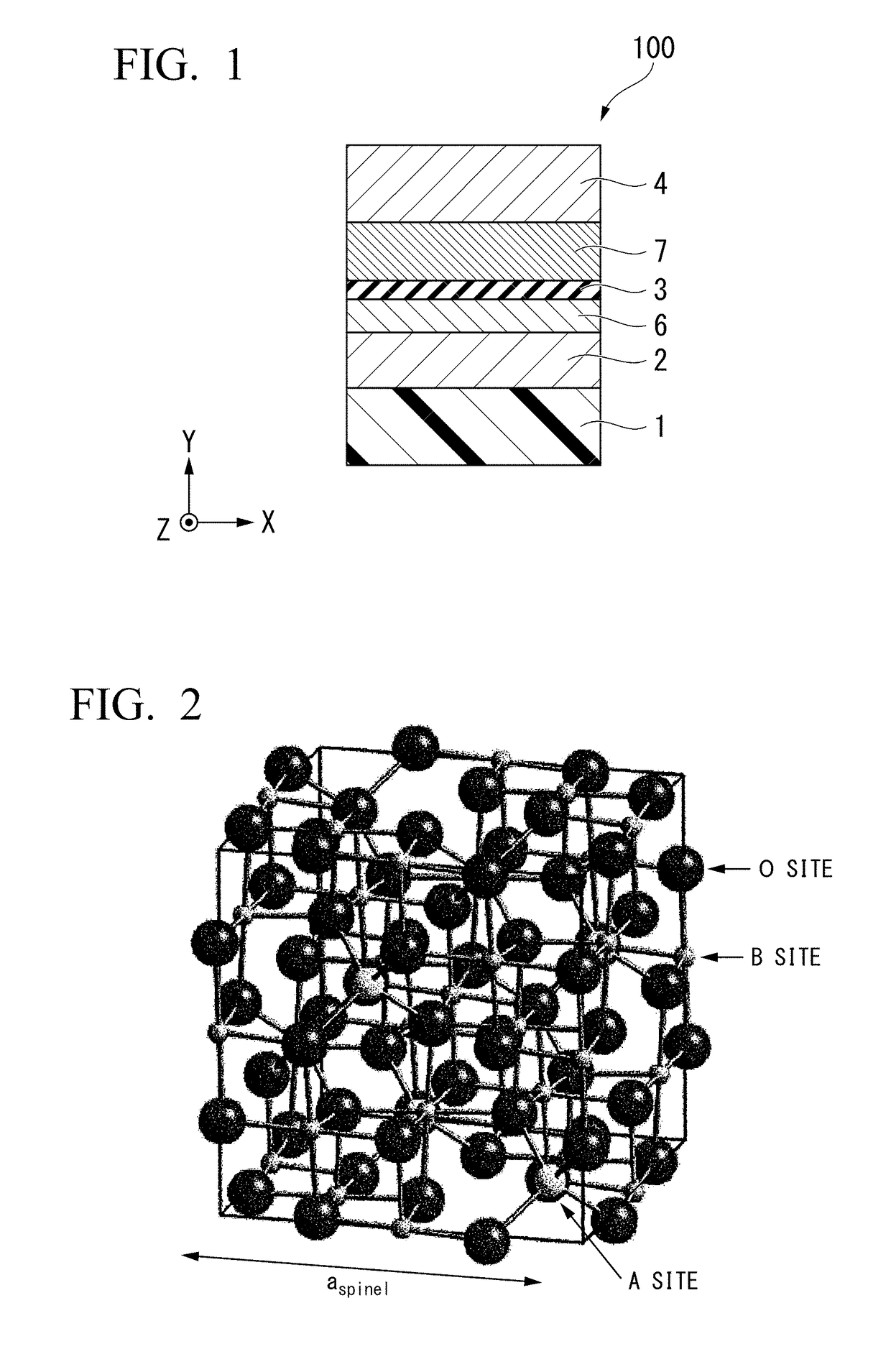Magnetoresistance effect element
- Summary
- Abstract
- Description
- Claims
- Application Information
AI Technical Summary
Benefits of technology
Problems solved by technology
Method used
Image
Examples
first embodiment
[0047]A magnetoresistance effect element 100 according to the first embodiment will be described. The magnetoresistance effect element 100 has a laminate in which an underlayer 2, a first ferromagnetic metal layer 6, a tunnel barrier layer 3, and a second ferromagnetic metal layer 7 are laminated in that order. The underlayer 2 is made of TiN, VN, or mixed crystals thereof. The tunnel barrier layer 3 is characterized in that it is made of a compound represented by the following composition formula (1) having a spinel structure.
AxIn2Oy (1)
[0048]In the formula, A is a non-magnetic divalent cation and represents cations of one or more elements selected from the group consisting of magnesium, zinc, and cadmium, x represents a number satisfying 0<x≦2, and preferably x<1, and y represents a number satisfying 0<y≦4.
(Basic Structure)
[0049]In the example illustrated in FIG. 1, the magnetoresistance effect element 100 is provided on a substrate 1, and is a laminated structure having the unde...
second embodiment
[0091]A difference between a second embodiment and the first embodiment is only a method of forming a tunnel barrier layer. In the first embodiment, the tunnel barrier layer is formed by repeatedly performing formation of a metal film, oxidation, formation of a metal film, and oxidation. In the second embodiment, in the oxidation process, a temperature of the substrate is cooled to −70 to −30° C., and then oxidation is performed. When the substrate is cooled, a temperature gradient occurs between the substrate and a vacuum or between the substrate and plasma. First, when oxygen is brought into contact with a surface of the substrate, it reacts with a metal material and oxidation occurs. However, since the temperature is low, oxidation does not proceed. Accordingly, it is easy to adjust an amount of oxygen in the tunnel barrier layer. In addition, when the temperature gradient is formed, it is easy to adjust epitaxial growth (lattice-matched growth). Since crystal growth proceeds acc...
example 1
[0098]Hereinafter, an example of the method of producing the magnetoresistance effect element according to the first embodiment will be described. Film formation was performed on the substrate 1 on which a thermally oxidized silicon film was provided using a magnetron sputtering method. First, TiN acting as the underlayer 2 was formed on the upper surface of the substrate 1 at 4 nm. The underlayer 2 was obtained by using a Ti target as a target, forming a film of about 10 nm according to the reactive sputtering method using a mixed gas including Ar and nitrogen at a ratio of 1:1 as sputtering gas, and polishing the film using a CMP method to reach the thickness. Next, CoFe was formed on the underlayer 2 as the first ferromagnetic metal layer 6 at 5 nm.
[0099]Next, the tunnel barrier layer 3 was formed on the first ferromagnetic metal layer 6. The method of forming the tunnel barrier layer 3 was as follows. A target having a composition of an MgIn2 alloy was sputtered, and MgIn2 was f...
PUM
 Login to View More
Login to View More Abstract
Description
Claims
Application Information
 Login to View More
Login to View More - R&D
- Intellectual Property
- Life Sciences
- Materials
- Tech Scout
- Unparalleled Data Quality
- Higher Quality Content
- 60% Fewer Hallucinations
Browse by: Latest US Patents, China's latest patents, Technical Efficacy Thesaurus, Application Domain, Technology Topic, Popular Technical Reports.
© 2025 PatSnap. All rights reserved.Legal|Privacy policy|Modern Slavery Act Transparency Statement|Sitemap|About US| Contact US: help@patsnap.com



